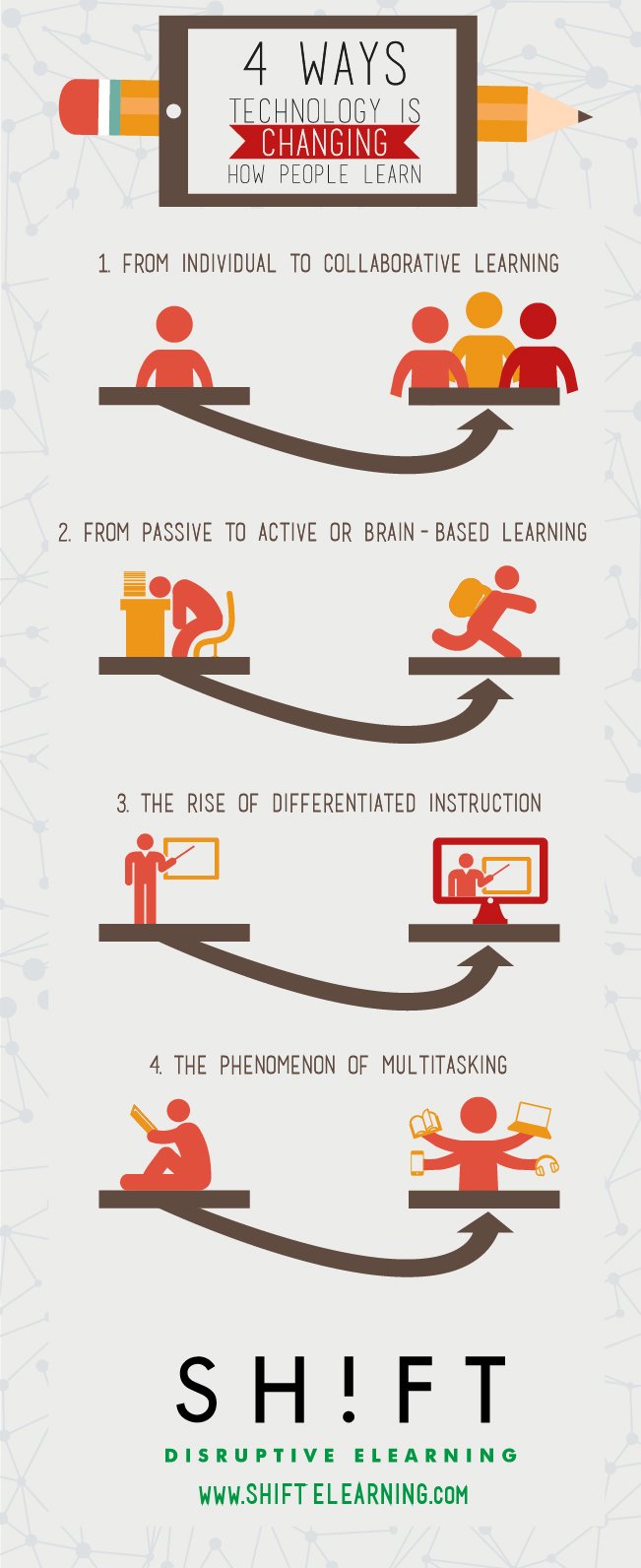Today, more than ever before, technology plays an important role in society. It is changing and will continue to change every aspect of how we live. It is changing the way we communicate, the way we do business, how we learn and teach, and even it’s changing the way our brains work.
Because the arrival of technology, the learning environment is changing. Students have more options than they ever would have imagined. In olden days, people used to only learn at a classroom. But today, people just need a computer and WIFI. They learn when it is convenient for them, at home or a coffee shop. As the skills, knowledge, and needs of the student change, so does the role of the teacher.
To provide the best possible learning experience, we as learning professionals have to adapt and find new ways to meet the changing needs of our learners. We must understand and embrace the meaning and the implications of these changes in the learning process.
Here are four ways technology is changing how people learn:
1) From Individual to Collaborative Learning
We used to mostly learn through individual-based courses and activities. There were fellow students, yes, but these were kept to a minimum. With the introduction of new technologies, however, learning has shifted from an almost individual-only endeavor to a collaborative activity.
By collaborative learning, we mean a situation in which two or more people learn or attempt to learn something together. Speaking of collaborative learning we think about problem-based, discussions, reflection and other ways in which students are an active part in the learning process.
Collaboration is no longer considered a nice add-on, it has become a necessary feature. The reality is that a plethora of tools facilitate or even encourage cooperation—from social network to instant messaging applications. Take Google Drive, Dropbox, Evernote, and popular task management software such as Astrid and Todoist. These apps are ready for collaboration.
This is an inevitable consequence brought about by the Internet. We can now communicate, real-time or not, with people whenever and wherever we're able. In web sessions or web-enabled class, students from all over the world turn to each other for help and connect in virtual classrooms. They find others who share their interests and collaborative with them as their course progress.
Today's much improved collaboration process and tools, more importantly, are filling the lack of "human touch," which has long been a criticism of online learning. Technology is no longer a barrier to genuine interaction. It is, instead, an enabler that affords students a humanized, learning experience—especially online. It not only supports cognitive processes, but also socio-emotional processes by involving learners in “getting to know each other, committing to social relationships, developing trust and belonging, and build a sense of on-line community.”
2) From Passive to Active or Brain-based Learning
This shift from passive to active learning or from a teacher-centered to a student-centered approach is probably the most positive consequence of technology.
Learners are no longer content-receptors merely taking down notes or listening to teachers talk for hours without pause. They now have a different set of expectations when it comes to learning. They actually want to participate or to have a say and maintain a sense of control over their lessons.
These active learners usually turn to mobile apps to learn whenever and wherever they can. They turn to the web to directly access information and, eventually, solve a problem. They still turn to their teachers or instructors but only to seek guidance.
Technology, then, becomes a tool for active learning. Through it, learners are able to research, communicate and solve problems. Whenever they navigate the web, they are able to directly access a huge library of information. The web offers them a plethora of data, not just text. The web is hypermedia, not linear. Most importantly, the web offers them freedom to learn according to paths of their own choosing. Learners can be authors and problem solvers, not just spectators.
Passive activities are being outdated while teachers are now occupying another significant role as guides. Blackboard’s SEO Sig Behren confirmed this in an article he wrote for USNews last year."If we actually want to engage active learners, learning needs to become much more open, mobile, socia and analutical" he said..
3) The Rise of Differentiated Instruction
Perhaps even more valuable than collaboration is the Web’s ability to bring complete personalization to the learning experience. Learners within any single 'class' are likely to have multiple needs to fulfill and not all of them aim toward the same learning goal. Each of them has his or her own set of concerns, agendas, abilities, values and priorities.
This is why it's extremely crucial to apply different types of instruction to different learners. No single method can accommodate all their learning needs. A flexible and personalized approach to content delivery is a must.
Technology, after all, not only facilitates collaborative learning, it also enables instructors to cater to the needs of individual learners. In fact, a hybrid of self-study, individualized instruction and group study has proven effective time and again. Carol Tomlinson, an expert on differentiation, has already documented the success of students who are taught based on their learning profiles and readiness levels.
Technology, after all, not only facilitates collaborative learning, it also enables instructors to cater to the needs of individual learners. It provides students with different avenues to acquiring content; to the processing, constructing, or making sense of ideas. In fact, a hybrid of self-study, adaptive instruction and peer network support has proven effective time and again. Carol Tomlinson, an expert on differentiation, has already documented the success of students who are taught based on their learning profiles and readiness levels.
4. The Phenomenon of Multitasking
Multi-tasking with technologies is perceived to be “easy”, especially among younger adults who are likely to be engaged in educational studies (Carrier, Cheever, Rosen, Benitez, & Chang, 2009). However, its proven that under most conditions, the brain cannot do two complex tasks at the same time. It can happen only when the two tasks are both very simple and when they don’t compete with each other for the same mental resources.
Imagine a student switching from one tab to another, or from a desktop screen to a smartphone screen. It took him more than hour to finish your less-than-1000-words assigned reading. He remembered less than half of it and got some of his facts mixed up. The culprit, clearly, is his lack of focus. He multi-tasked and thus unable to sustain concentration on his studies.
This rise in multi-tasking, easily distracted students has been a seemingly insurmountable challenge to eLearning professionals. Media multi-tasking negatively affects how they absorb and process information.





